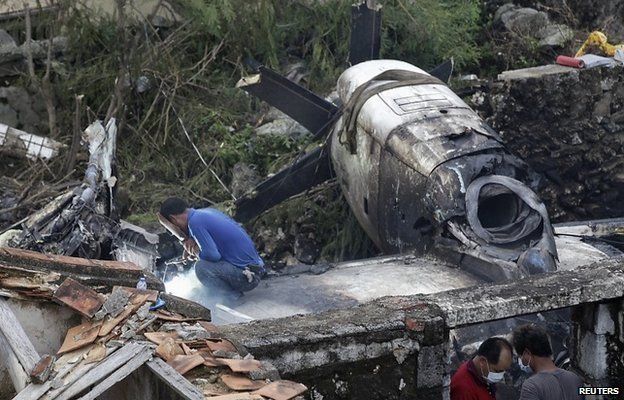How odd is a cluster of plane crashes?
- Published

In the space of eight days, three passenger planes have been lost in mid-flight. A cluster of disasters so close together may seem an unlikely coincidence but is it?
The first crash happened on Thursday 17 July, when Malaysia Airlines flight MH17 fell from the sky over eastern Ukraine, apparently brought down by a missile. Seven days later a plane crashed in Taiwan (above), and on the eighth day another flight went down en route to Algeria from Burkina Faso. In all, 462 people are thought to have died.
Some people may suddenly be wondering how safe it is to fly.
But Harro Ranter, director of the Aviation Safety Network which catalogues plane crashes, says clusters of accidents are not unusual. Analysing the number and frequency of fatal crashes of aircraft capable of carrying 14 or more passengers since 1990, he finds 45 dates when there have been two or more crashes (excluding collisions).
In 105 cases there have been accidents on consecutive days. In fact, Ranter says it is more common for an accident to happen just one day after another crash than two, three or more days later.
Why might this be?
"It is essentially a coincidence, except for the technicality that adverse weather involving thunderstorms and typhoons is more common in some seasons than others," says Arnold Barnett, a Professor of Statistics at the Massachusetts Institute of Technology.
However, Barnett also draws attention to the theory of Poisson distribution, which implies that short intervals between crashes are actually more probable than long ones.
"Suppose that there is an average of one fatal accident per year, meaning that the chance of a crash on any given day is one in 365," says Barnett. "If there is a crash on 1 August, the chance that the next crash occurs one day later on 2 August is 1/365. But the chance the next crash is on 3 August is (364/365) x (1/365), because the next crash occurs on 3 August only if there is no crash on 2 August."
"It seems counterintuitive, but the conclusion follows relentlessly from the laws of probability," Barnett says.
About 500 passengers die in crashes involving scheduled commercial flights each year, and although that number has already been exceeded in 2014 - by about 200 - we should not expect the coming months to have an unusually high number of accidents.
Barnett points out that during April, May and June this year, there were no fatal accidents at all involving scheduled commercial flights. "It is hard to imagine that the skill that led to this marvellous record somehow disappeared in July," he says.
He calculates that in developed countries the chance of dying is about one in 25 million per flight. "A child at a UK airport is more likely to grow up to be prime minister than perish on the forthcoming flight... the child is more likely to win an Olympic gold medal or receive the Nobel prize in physics."
Even in the world's least developed countries the chance of dying on a flight is about one in 750,000.
As for the occurrence of three fatal crashes in eight days, David Spiegelhalter, Professor for the Public Understanding of Risk at Cambridge University, has worked out that there is about a six in 10 chance that we should see such a large cluster during a 10-year period, and "the most likely maximum number of crashes of commercial planes with over 18 passengers in any eight-day window over 10 years is exactly three".
Subscribe to the BBC News Magazine's email newsletter to get articles sent to your inbox.